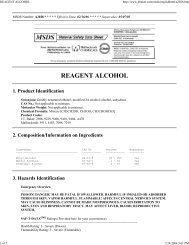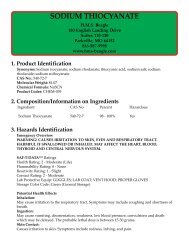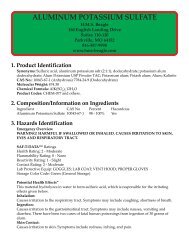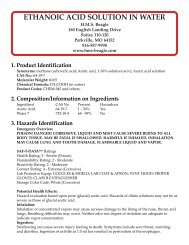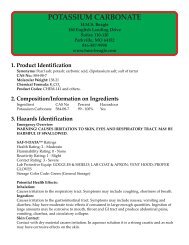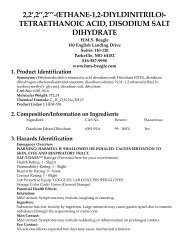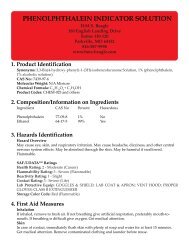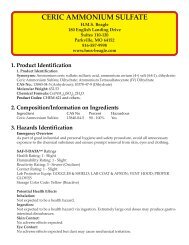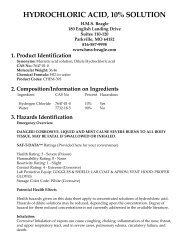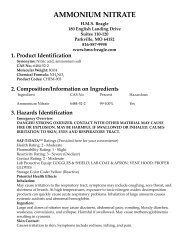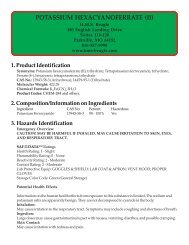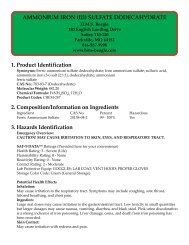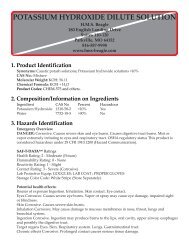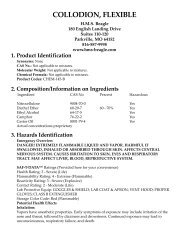POTASSIUM CHROMATE - HMS Beagle
POTASSIUM CHROMATE - HMS Beagle
POTASSIUM CHROMATE - HMS Beagle
You also want an ePaper? Increase the reach of your titles
YUMPU automatically turns print PDFs into web optimized ePapers that Google loves.
<strong>POTASSIUM</strong> <strong>CHROMATE</strong>H.M.S. <strong>Beagle</strong>180 English Landing DriveSuites 110-120Parkville, MO 64152816-587-9998www.hms-beagle.com1. Product IdentificationSynonyms: Chromic acid, dipotassium salt; dipotassium chromate; bipotassium chromateCAS No.: 7789-00-6Molecular Weight: 194.19Chemical Formula: K 2CrO 4Product Codes: CHEM-394 and others.2. Composition/Information on IngredientsIngredient CAS No Percent HazardousPotassium Chromate 7789-00-6 99 - 100% Yes3. Hazards IdentificationEmergency OverviewDANGER! STRONG OXIDIZER. CONTACT WITH OTHER MATERIAL MAY CAUSE AFIRE. CORROSIVE. CAUSES SEVERE BURNS TO EVERY AREA OF CONTACT. HARMFULIF SWALLOWED OR INHALED. AFFECTS THE RESPIRATORY SYSTEM, LIVER, KIDNEYS,EYES, SKIN AND BLOOD. MAY CAUSE ALLERGIC REACTION. CANCER HAZARD. CANCAUSE CANCER. Risk of cancer depends on duration and level of exposure.SAF-T-DATA (tm) RatingsHealth Rating: 3 - Severe (Life)Flammability Rating: 3 - Severe (Flammable)Reactivity Rating: 1 - SlightContact Rating: 2 - ModerateLab Protective Equip: GOGGLES & SHIELD; LAB COAT & APRON; VENT HOOD; PROPERGLOVES; CLASS B EXTINGUISHERStorage Color Code: Red (Flammable)Potential Health EffectsInhalation:Corrosive. Extremely destructive to tissues of the mucous membranes and upper respiratorytract. May cause ulceration and perforation of the nasal septum. Symptoms may include sorethroat, coughing, shortness of breath, and labored breathing. May produce pulmonarysensitization or allergic asthma. Higher exposures may cause pulmonary edema.
Ingestion:Corrosive. Swallowing can cause severe burns of the mouth, throat, and stomach, leading todeath. Can cause sore throat, vomiting, diarrhea. May cause violent gastroenteritis, peripheralvascular collapse, dizziness, intense thirst, muscle cramps, shock, coma, abnormal bleeding,fever, liver damage and acute renal failure.Skin Contact:Corrosive. Symptoms of redness, pain, and severe burn can occur. Dusts and strong solutionsmay cause severe irritation. Contact with broken skin may cause ulcers (chrome sores) andabsorption, which may cause systemic poisoning, affecting kidney and liver functions. May causeskin sensitization.Eye Contact:Corrosive. Contact can cause blurred vision, redness, pain and severe tissue burns. May causecorneal injury or blindness.Chronic Exposure:Repeated or prolonged exposure can cause ulceration and perforation of the nasal septum,respiratory irritation, liver and kidney damage and ulceration of the skin. Ulcerations at firstmay be painless, but may penetrate to the bone producing “chrome holes.” Known to be ahuman carcinogen.Aggravation of Pre-existing Conditions:Persons with pre-existing skin disorders, asthma, allergies or known sensitization to chromicacid or chromates may be more susceptible to the effects of this material.4. First Aid MeasuresInhalation:Remove to fresh air. If not breathing, give artificial respiration. If breathing is difficult, giveoxygen. Get medical attention immediately.Ingestion:If swallowed, DO NOT INDUCE VOMITING. Give large quantities of water. Never give anythingby mouth to an unconscious person. Get medical attention immediately.Skin Contact:Immediately flush skin with plenty of water for at least 15 minutes while removingcontaminated clothing and shoes. Get medical attention immediately. Wash clothing beforereuse. Thoroughly clean shoes before reuse.Eye Contact:Immediately flush eyes with plenty of water for at least 15 minutes, lifting lower and uppereyelids occasionally. Get medical attention immediately.5. Fire Fighting MeasuresFire:Not combustible, but substance is a strong oxidizer and its heat of reaction with reducing agentsor combustibles may cause ignition. Releases oxygen, upon decomposition, which enhancescombustion.Explosion:Contact with oxidizable substances may cause extremely violent combustion. Becomes a possibleexplosion hazard when shocked, heated, or exposed to hydrazine.Fire Extinguishing Media:Flood with large amounts of water. Water spray may be used to keep fire exposed containerscool. Do not allow water runoff to enter sewers or waterways.
Special Information:In the event of a fire, wear full protective clothing and NIOSH-approved self-containedbreathing apparatus with full facepiece operated in the pressure demand or other positivepressure mode.6. Accidental Release MeasuresVentilate area of leak or spill. Wear appropriate personal protective equipment as specified inSection 8. Spills: Sweep up and containerize for reclamation or disposal. Vacuuming or wetsweeping may be used to avoid dust dispersal. US Regulations (CERCLA) require reportingspills and releases to soil, water and air in excess of reportable quantities. The toll free numberfor the US Coast Guard National Response Center is (800) 424-8802.7. Handling and StorageKeep in a tightly closed container. Protect from physical damage. Store in a cool, dry, ventilatedarea away from sources of heat, moisture and incompatibilities. Do not store on wooden floors.Wear special protective equipment (Sec. 8) for maintenance break-in or where exposures mayexceed established exposure levels. Wash hands, face, forearms and neck when exiting restrictedareas. Shower, dispose of outer clothing, change to clean garments at the end of the day. Avoidcross-contamination of street clothes. Wash hands before eating and do not eat, drink, or smokein workplace. Containers of this material may be hazardous when empty since they retainproduct residues (dust, solids); observe all warnings and precautions listed for the product.8. Exposure Controls/Personal ProtectionAirborne Exposure Limits:OSHA Permissible Exposure Limit (PEL): For chromic acid and chromates, as CrO3 = 0.1 mg/m3(ceiling)ACGIH Threshold Limit Value (TLV): For water-soluble Cr(VI) compounds, as Cr = 0.05 mg/m3(TWA), A1 - confirmed human carcinogen.Ventilation System:A system of local and/or general exhaust is recommended to keep employee exposures below theAirborne Exposure Limits. Local exhaust ventilation is generally preferred because it can controlthe emissions of the contaminant at its source, preventing dispersion of it into the general workarea. Please refer to the ACGIH document, Industrial Ventilation, A Manual of RecommendedPractices, most recent edition, for details.Personal Respirators (NIOSH Approved):If the exposure limit is exceeded and engineering controls are not feasible, a half facepieceparticulate respirator (NIOSH type N95 or better filters) may be worn for up to ten times theexposure limit or the maximum use concentration specified by the appropriate regulatoryagency or respirator supplier, whichever is lowest.. A full-face piece particulate respirator(NIOSH type N100 filters) may be worn up to 50 times the exposure limit, or the maximum useconcentration specified by the appropriate regulatory agency, or respirator supplier, whichever islowest. If oil particles (e.g. lubricants, cutting fluids, glycerine, etc.) are present, use a NIOSHtype R or P filter. For emergencies or instances where the exposure levels are not known, use afull-facepiece positive-pressure, air-supplied respirator. WARNING: Air-purifying respirators donot protect workers in oxygen-deficient atmospheres.Skin Protection:Wear impervious protective clothing, including boots, gloves, lab coat, apron or coveralls, asappropriate, to prevent skin contact.
Eye Protection:Use chemical safety goggles and/or full face shield where dusting or splashing of solutions ispossible. Maintain eye wash fountain and quick-drench facilities in work area.9. Physical and Chemical PropertiesAppearance:Yellow crystals.Odor:Odorless.Solubility:69.9g/100 g water @ 20°C (68°F).Density:2.73pH:Aqueous soln. is alkaline to litmus.% Volatiles by volume @ 21°C (70°F):0Boiling Point:No information found.Melting Point:975°C (1787°F)Vapor Density (Air=1):6.7Vapor Pressure (mm Hg):Zero.Evaporation Rate (BuAc=1):No information found.10. Stability and ReactivityStability:Stable under ordinary conditions of use and storage.Hazardous Decomposition Products:Burning may produce chrome oxides.Hazardous Polymerization:Will not occur.Incompatibilities:Reducing agents, hydrazine, and flammable materials. Any combustible, organic or other readilyoxidizable material (paper, wood, sulfur, aluminum or plastics).Conditions to Avoid:Heat, incompatibles.11. Toxicological InformationOral rat LD50: 180 mg/kg. Investigated as a tumorigen, mutagen, reproductive effector.Cancer ListsNTP CarcinogenIngredient Known Anticipated IARC CategoryPotassium Chromate (7789-00-6) Yes No 1
12. Ecological InformationEnvironmental Fate:When released into the soil, this material may leach into groundwater. When released into water,this material will not evaporate. This material may bioaccumulate to some extent. When releasedinto the air, this material may be removed from the atmosphere to a moderate extent by wetdeposition.Environmental Toxicity:Dangerous to the environment. Very toxic to aquatic organisms; may cause long term adverseeffects in the aquatic environment.13. Disposal ConsiderationsWhatever cannot be saved for recovery or recycling should be handled as hazardous waste andsent to a RCRA approved waste facility. Processing, use or contamination of this product maychange the waste management options. State and local disposal regulations may differ fromfederal disposal regulations. Dispose of container and unused contents in accordance withfederal, state and local requirements.14. Transport InformationDomestic (Land, D.O.T.)Proper Shipping Name: RQ, OXIDIZING SOLID, CORROSIVE, N.O.S. (<strong>POTASSIUM</strong><strong>CHROMATE</strong>)Hazard Class: 5.1, 8UN/NA: UN3085Packing Group: IIIInformation reported for product/size: 375LBInternational (Water, I.M.O.)Proper Shipping Name: OXIDIZING SOLID, CORROSIVE, N.O.S. (<strong>POTASSIUM</strong> <strong>CHROMATE</strong>)Hazard Class: 5.1, 8UN/NA: UN3085Packing Group: IIIInformation reported for product/size: 375LB15. Regulatory InformationChemical Inventory Status - Part 1Ingredient TSCA EC Japan AustraliaPotassium Chromate (7789-00-6) Yes Yes Yes YesChemical Inventory Status - Part 2CanadaIngredient Korea DSL NDSL Phil.Potassium Chromate (7789-00-6) Yes Yes No YesFederal, State & International Regulations - Part 1SARA 302 SARA 313Ingredient RQ TPQ List Chemical Catg.Potassium Chromate (7789-00-6) No No No Chromium compound
Federal, State & International Regulations - Part 2RCRA TSCAIngredient CERCLA 261.33 8(d)Potassium Chromate (7789-00-6) 10 No NoChemical Weapons Convention: No TSCA 12(b): Yes CDTA: YesSARA 311/312: Acute: Yes Chronic: Yes Fire: Yes Pressure: NoReactivity: Yes (Pure / Solid)WARNING:THIS PRODUCT CONTAINS A CHEMICAL(S) KNOWN TO THE STATE OF CALIFORNIA TOCAUSE CANCER.Australian Hazchem Code: None allocated.Poison Schedule: S6WHMIS:This MSDS has been prepared according to the hazard criteria of the Controlled ProductsRegulations (CPR) and the MSDS contains all of the information required by the CPR.16. Other InformationLabel Hazard Warning:DANGER! STRONG OXIDIZER. CONTACT WITH OTHER MATERIAL MAY CAUSE A FIRE.CORROSIVE. CAUSES SEVERE BURNS TO EVERY AREA OF CONTACT. HARMFUL IFSWALLOWED OR INHALED. AFFECTS THE RESPIRATORY SYSTEM, LIVER, KIDNEYS, EYES,SKIN AND BLOOD. MAY CAUSE ALLERGIC REACTION. CANCER HAZARD. CAN CAUSECANCER. Risk of cancer depends on duration and level of exposure.Label Precautions:Keep from contact with clothing and other combustible materials.Do not get in eyes, on skin, or on clothing.Do not breathe dust or mist from solutions.Keep container closed.Use only with adequate ventilation.Wash thoroughly after handling.Store in a tightly closed container.Do not store near combustible materials.Label First Aid:In case of contact, immediately flush eyes or skin with plenty of water for at least 15 minuteswhile removing contaminated clothing and shoes. Wash clothing before reuse. If inhaled,remove to fresh air. If not breathing, give artificial respiration. If breathing is difficult, giveoxygen. If swallowed, DO NOT INDUCE VOMITING. Give large quantities of water. Never giveanything by mouth to an unconscious person. In all cases get medical attention immediately.Product Use:Laboratory Reagent; Consumer Hobby.Revision Information:None
Disclaimer:************************************************************************************************H.M.S. <strong>Beagle</strong> and/or Rainbow House, LLC, provides the information contained herein in goodfaith but makes no representation as to its comprehensiveness or accuracy. This document isintended only as a guide to the appropriate precautionary handling of the material by a properlytrained person using this product. Individuals receiving the information must exercise theirindependent judgment in determining its appropriateness for a particular purpose. NEITHERH.M.S. BEAGLE NOR RAINBOW HOUSE, LLC MAKE NO REPRESENTATIONS ORWARRANTIES, EITHER EXPRESS OR IMPLIED, INCLUDING WITHOUT LIMITATIONANY WARRANTIES OF MERCHANTABILITY, FITNESS FOR A PARTICULAR PURPOSEWITH RESPECT TO THE INFORMATION SET FORTH HEREIN OR THE PRODUCT TOWHICH THE INFORMATION REFERS. ACCORDINGLY, H.M.S. BEAGLE AND RAINBOWHOUSE, LLC, WILL NOT BE RESPONSIBLE FOR DAMAGES RESULTING FROM USE OFOR RELIANCE UPON THIS INFORMATION.************************************************************************************************Prepared by: John Farrell KuhnsPhone Number: 816-587-9998 (U.S.A.)



